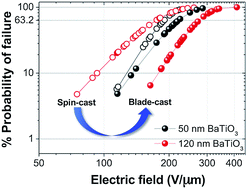Enhancement of breakdown strength and energy density in BaTiO3/ferroelectric polymer nanocomposites via processing-induced matrix crystallinity and uniformity†
Abstract
We have investigated the impact of the processing methodology on nanocomposite thin films formed via blade casting versus spin coating on the electric breakdown strength and energy storage properties of BaTiO3 nanoparticle/poly(vinylidene fluoride-co-hexafluoropropylene) nanocomposites. Nanocomposite films containing 50% volume loading of surface-modified BaTiO3 nanoparticles fabricated by the use of blade casting showed a denser and more uniform morphology, and larger polymer crystallite domains, relative to those obtained via spin coating. The improved morphology has resulted in an increase of up to 60% in the breakdown strength and in energy density by a factor of ∼2–3 and for blade-cast vs. spin coated nanocomposite films containing 50 or 120 nm BaTiO3 nanoparticles, yielding a maximum extractable energy density of 7 J cm−3. We attribute the increase in energy density and dielectric breakdown strength to the effects of the improved uniformity and the formation of polymer nanocrystalline domains in the matrix, as shown by cross-sectional SEM and topological AFM images, and X-ray diffraction results. These results stress the importance of controlling nanoscale morphology for optimizing energy storage capacity of solution-processed nanocomposite thin films for pulsed power, gate dielectrics, and other thin-film power applications.


 Please wait while we load your content...
Please wait while we load your content...